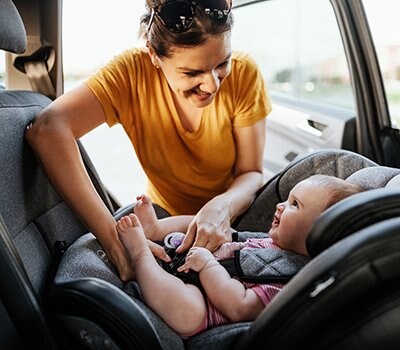Car Seat Safety

As you prepare for the arrival of your baby you'll need to prepare many areas of your home. But before you can even bring your new bundle of joy home, you'll have to make sure your vehicle is equipped with an infant car safety seat. A car seat is vital to protecting your child in a car accident, but it must be installed properly in order for it to be effective. Car seat guidelines will vary as your child develops, but when it comes to your infant, keep these safety tips in mind.
Type of Seat
The rear-facing direction is the safest position for your newborn, as it helps absorb any force that may injure your baby's spine and head during a car accident or impact. The seat should always be installed in the backseat, as airbags in the front can be extremely dangerous for the fragile body of a baby. Your baby should remain in a rear-facing seat for as long as possible, until they become too big in weight or height for the seats limit, which is typically 2 years of age. You shouldn't be concerned if your child's feet begin to touch the back of the seat – this doesn't mean they have outgrown the seat in most instances, but make sure to read the manufacturers recommendations.
Correct Use
Having a car seat is important, but if it's not installed properly it can do more harm than good. Make sure to read the installation instructions carefully. The car seat should fit tightly in the back seat of your vehicle. If you can move the seat even one inch, then it is not tight enough and you will need to readjust the anchors where the seat belt attaches to your vehicle. If you're having trouble getting the anchor or seat belts to attach properly, there are specialists that can assess the installation of the seat. These individuals are usually found at police stations, fire stations, and hospitals. A directory to locate a car seat specialist in your area can be found online.
In addition to proper installation, take note when placing the seat in your vehicle that the center seat has been determined as the safest place. Anyone traveling in the backseat should also be wearing a seat belt. If a crash were to occur, an unbuckled individual becomes projectile putting your infant and any others at dangerous risk for injury.
Remove Bulk
Just as you would dress your child appropriately for a special occasion, you should also dress your child for car seat safety too. When strapping your child into their seat, the harness should be snug against their body to help restrict their movement. Remove any bulky layers like snowsuits, puffy jackets, or blankets before strapping your child into their car seat. These bulky layers give the impression that your child is safely and tightly strapped into their seat, but in reality if a crash were to happen, the added bulk would compress in the force of the accident and lead to loose straps that your child could easily fall out of. Instead of puffy layers, try adding several layers of light clothing if you are concerned your child may be chilly. There are also a variety of products that can be used to cover your child to add warmth after you've put them in their seat.
If you're looking for a pediatrician for your newborn or child, our providers at Sturdy Pediatric Associates, South Avenue Pediatrics, and Pleasant Street Pediatrics are accepting new patients.